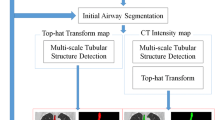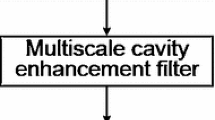Abstract
Purpose
Airway tree segmentation plays a pivotal role in chest computed tomography (CT) analysis tasks such as lesion localization, surgical planning, and intra-operative guidance. The remaining challenge is to identify small bronchi correctly, which facilitates further segmentation of the pulmonary anatomies.
Methods
A three-dimensional (3D) multi-scale feature aggregation network (MFA-Net) is proposed against the scale difference of substructures in airway tree segmentation. In this model, the multi-scale feature aggregation (MFA) block is used to capture the multi-scale context information, which improves the sensitivity of the small bronchi segmentation and addresses the local discontinuities. Meanwhile, the concept of airway tree partition is introduced to evaluate the segmentation performance at a more granular level.
Results
Experiments were conducted on a dataset of 250 CT scans, which were annotated by experienced clinical radiologists. Through the airway partition, we evaluated the segmentation results of the small bronchi compared with the state-of-the-art methods. Experiments show that MFA-Net achieves the best performance in the Dice similarity coefficient (DSC) in the intra-lobar airway and improves the true positive rate (TPR) by 7.59% on average. Besides, in the entire airway, the proposed method achieves the best results in DSC and TPR scores of 86.18% and 79.31%, respectively, with the consequence of higher false positives.
Conclusion
The MFA-Net is competitive with the state-of-the-art methods. The experiment results indicate that the MFA block improves the performance of the network by utilizing multi-scale context information. More accurate segmentation results will be more helpful in further clinical analysis.





Similar content being viewed by others
References
Aykac D, Hoffman EA, McLennan G, Reinhardt JM (2003) Segmentation and analysis of the human airway tree from three-dimensional x-ray ct images. IEEE Trans Med Imaging 22(8):940–950
Charbonnier JP, Van Rikxoort EM, Setio AA, Schaefer-Prokop CM, van Ginneken B, Ciompi F (2017) Improving airway segmentation in computed tomography using leak detection with convolutional networks. Med Image Anal 36:52–60
Chen S, Guo J, Wang C, Xu X, Yi Z, Li W (2019) Deeplnanno: a web-based lung nodules annotating system for ct images. J Med Syst 43(7):197
Chen W, Zheng R, Baade PD, Zhang S, Zeng H, Bray F, Jemal A, Yu XQ, He J (2016) Cancer statistics in china, 2015. CA Cancer J Clin 66(2):115–132
Çiçek Ö, Abdulkadir A, Lienkamp SS, Brox T, Ronneberger O (2016) 3d u-net: learning dense volumetric segmentation from sparse annotation. International conference on medical image computing and computer-assisted intervention. Springer, New York, pp 424–432
Fedorov A, Beichel R, Kalpathy-Cramer J, Finet J, Fillion-Robin JC, Pujol S, Bauer C, Jennings D, Fennessy F, Sonka M, Buatti J, Aylward S, Miller JV, Pieper S, Kikinis R (2012) 3D slicer as an image computing platform for the quantitative imaging network. Magn Reson Imaging 30(9):1323–1341
Higgins WE, Ramaswamy K, Swift RD, McLennan G, Hoffman EA (1998) Virtual bronchoscopy for three-dimensional pulmonary image assessment: state of the art and future needs. Radiographics 18(3):761–778
Hoffman EA, McLennan G (1997) Assessment of the pulmonary structure-function relationship and clinical outcomes measures: quantitative volumetric ct of the lung. Acad Radiol 4(11):758–776
Jin D, Xu Z, Harrison AP, George K, Mollura DJ (2017) 3D convolutional neural networks with graph refinement for airway segmentation using incomplete data labels. International workshop on machine learning in medical imaging. Springer, New York, pp 141–149
Juarez AGU, Tiddens H, de Bruijne M (2018) Automatic airway segmentation in chest ct using convolutional neural networks. Image analysis for moving organ, breast, and thoracic images. Springer, New York, pp 238–250
Juarez AGU, Selvan R, Saghir Z, de Bruijne M (2019) A joint 3d unet-graph neural network-based method for airway segmentation from chest cts. International workshop on machine learning in medical imaging. Springer, New York, pp 583–591
Kingma DP, Ba J (2014) Adam: a method for stochastic optimization. arXiv preprint arXiv:1412.6980 [cs.LG]
Lee M, Lee JG, Kim N, Seo JB, Lee SM (2019) Hybrid airway segmentation using multi-scale tubular structure filters and texture analysis on 3d chest ct scans. J Digit Imaging 32(5):779–792
Meng Q, Kitasaka T, Nimura Y, Oda M, Ueno J, Mori K (2017) Automatic segmentation of airway tree based on local intensity filter and machine learning technique in 3d chest ct volume. Int J Comput Assist Radiol Surg 12(2):245–261
Qin Y, Chen M, Zheng H, Gu Y, Shen M, Yang J, Huang X, Zhu YM, Yang GZ (2019) Airwaynet: a voxel-connectivity aware approach for accurate airway segmentation using convolutional neural networks. arXiv preprint arXiv:1907.06852 [eess.IV]
Reinhardt JM, D’Souza N, Hoffman EA (1997) Accurate measurement of intrathoracic airways. IEEE Trans Med Imaging 16(6):820–827
Taha AA, Hanbury A (2015) Metrics for evaluating 3d medical image segmentation: analysis, selection, and tool. BMC Med Imaging 15(1):29
Xu Z, Bagci U, Foster B, Mollura DJ (2013) A hybrid multi-scale approach to automatic airway tree segmentation from ct scans. In: Proceedings of the 2013 IEEE 10th international symposium on biomedical imaging, IEEE, pp 1308–1311
Yun J, Park J, Yu D, Yi J, Lee M, Park HJ, Lee JG, Seo JB, Kim N (2019) Improvement of fully automated airway segmentation on volumetric computed tomographic images using a 2.5 dimensional convolutional neural net. Med Image Anal 51:13–20
Zhao T, Yin Z, Wang J, Gao D, Chen Y, Mao Y (2019) Bronchus segmentation and classification by neural networks and linear programming. International conference on medical image computing and computer-assisted intervention. Springer, New York, pp 230–239
Acknowledgements
This work was supported by the National Major Science and Technology Projects of China under Grant 2018AAA0100201 and the Major Scientific and Technological Projects of the New Generation of Artificial Intelligence in Sichuan Province in 2018 under Grant 2018GZDZX0035.
Author information
Authors and Affiliations
Corresponding authors
Ethics declarations
Conflict of interest
The authors declare that they have no conflict of interest.
Ethical approval
For this type of study, formal consent is not required.
Informed consent
Informed consent was obtained from all individual participants included in the study.
Additional information
Publisher's Note
Springer Nature remains neutral with regard to jurisdictional claims in published maps and institutional affiliations.
Rights and permissions
About this article
Cite this article
Zhou, K., Chen, N., Xu, X. et al. Automatic airway tree segmentation based on multi-scale context information. Int J CARS 16, 219–230 (2021). https://doi.org/10.1007/s11548-020-02293-x
Received:
Accepted:
Published:
Issue Date:
DOI: https://doi.org/10.1007/s11548-020-02293-x




